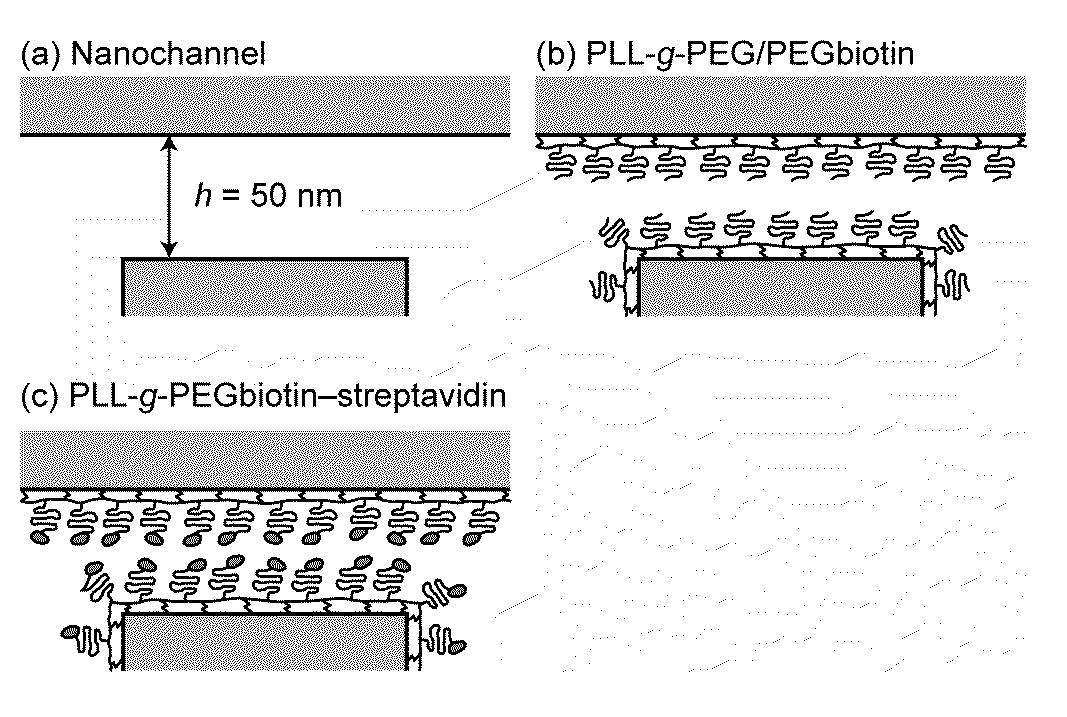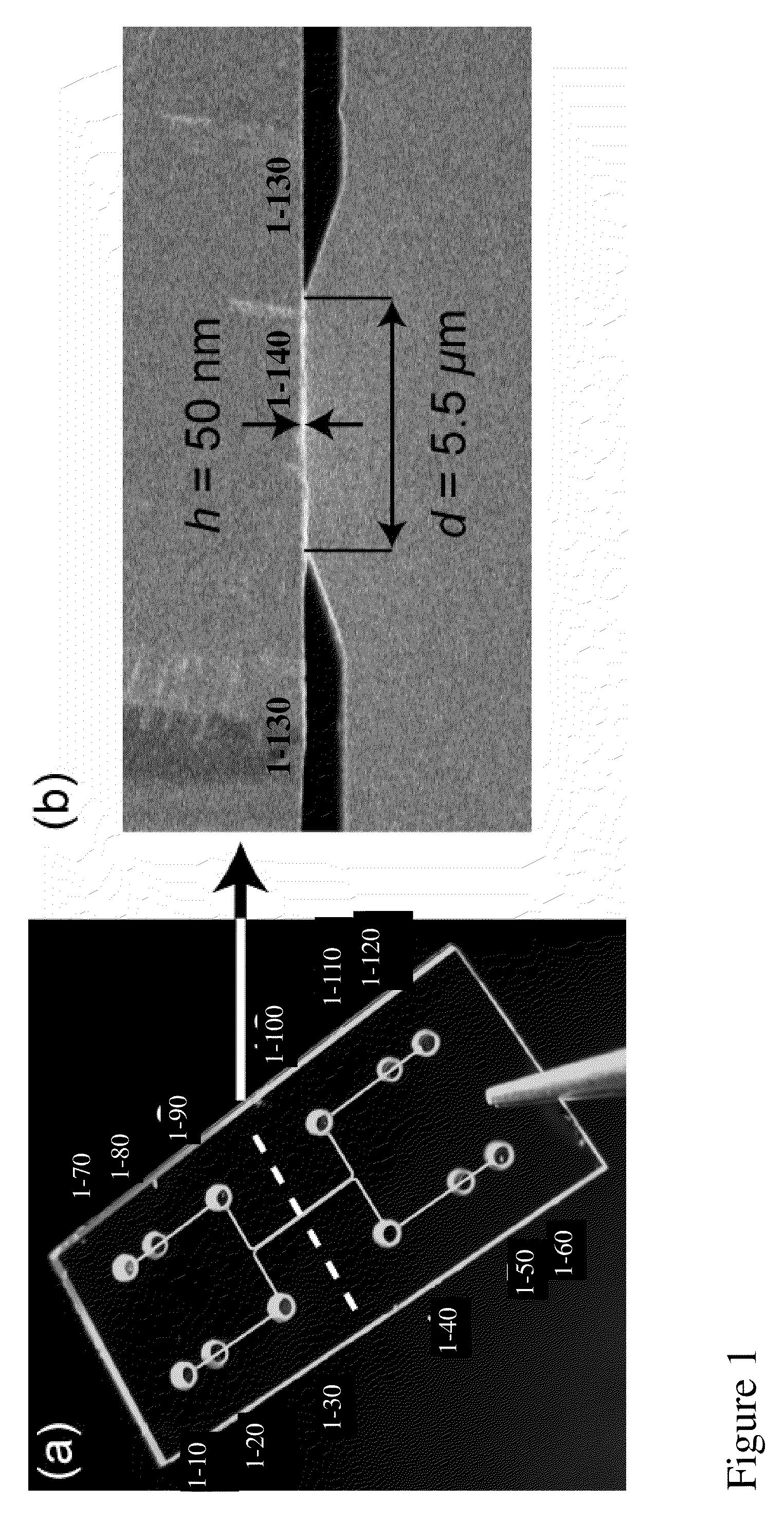Nanoconfinement- based devices and methods of use thereof
a technology of nanoconfinement and analyte detection, which is applied in the field of devices and methods for rapid analyte detection, can solve the problems of device limitations, analyte detection, and device limitations, and achieve the effects of improving the specificity of binding, improving the accuracy of assays, and fast binding
- Summary
- Abstract
- Description
- Claims
- Application Information
AI Technical Summary
Benefits of technology
Problems solved by technology
Method used
Image
Examples
example 1
Rapid Convection and Sensing Device
[0230]FIG. 1 describes an embodiment of a device of this invention, depicting a chip comprising nanochannels (1-140), placed proximally to abut microchannels (1-130). Access ports 1-10-1-60 are positioned to the left of the long axis of the microchannels depicted, and holes 1-70-1-120 to the right of the long axis of the microchannels depicted.
[0231]Ports 1-30 / 1-90 and 1-40 / 1-100 provide fluidic access to the microchannel, e.g. for introduction of sample and waste removal of each microchannel, respectively. Electrical contact can be made through the pads in ports 1-10 / 1-70 or 1-60 / 1-120, respectively. To control the pressure in the chip, and / or prevent liquid flow into the electrical contact sites, ports 1-20 / 1-50 and 1-80 / 1-110 may be sealed with nonconductive glue.
[0232]Different chip configurations were fabricated with 1-10, 1-20, 1-50, and 1-100 nanochannels joining the two microchannels. Each nanochannel had the following dimensions: height h=...
example 2
Detection of a Binding Event in Embodied Devices of this Invention
[0235]For electrical detection of immobilized proteins in nanochannels, streptavidin-biotin was chosen as the model receptor-ligand pair. To perform such bindings in nanochannels, surfaces were pre-coated with PLL(20)-g[3.5]-PEG(2) / PEG(3.4)-Biotin (50%) at 0.1 mg / ml (hereinafter referred to as “PLL-g-PEGbiotin”). This polymer is end-functionalized with biotin and therefore reacts selectively with streptavidin. Controls included surfaces pre-coated with 0.1 mg / ml PLL(20)-g[3.5]-PEG(2) (hereinafter referred to as “PLL-g-PEG”) layer, which reduces protein adsorption. The polymers are known to spontaneously adsorb from aqueous solutions to oxide surfaces due to the positively charged poly(L-lysine) group at neutral pH, are protein-resistant due to the poly(ethylene glycol) group forming a comblike structure, and can be end-functionalized to react selectively with a target molecule.
[0236]10 mM HEPES buffer solution having ...
example 3
Concentration-Dependent Effects on Diffusive Binding
[0246]To determine the lowest detectable concentration of biomolecules in a diffusion-limited reaction, the normalized conductance change was investigated as a function of the streptavidin concentration (FIG. 4). In this aspect, the lowest detectable streptavidin concentration in nanochannels is estimated to be 0.4 μM. At lower biomolecule concentrations, detected nanochannel conductance changes were within the repeatability error of ˜3%. The poor detectability at lower streptavidin concentrations can be attributed, in part, to the failure to achieve binding equilibrium.
[0247]The failure of detection of the lowest streptavidin concentrations in FIG. 4 may be attributable to the process of diffusion-limited patterning of nanochannels [see Karnik et al. Karnik, R.; Castelino, K.; Duan, C.; Majumdar, A. Nano Lett. 2006, 6, 1735]. Under diffusion, the coating time tdiff of a nanochannel with a length d is:
tdiff=Pγ0d22DAc(1)
[0248]where ...
PUM
| Property | Measurement | Unit |
|---|---|---|
| Length | aaaaa | aaaaa |
| Length | aaaaa | aaaaa |
| Length | aaaaa | aaaaa |
Abstract
Description
Claims
Application Information
 Login to View More
Login to View More - R&D
- Intellectual Property
- Life Sciences
- Materials
- Tech Scout
- Unparalleled Data Quality
- Higher Quality Content
- 60% Fewer Hallucinations
Browse by: Latest US Patents, China's latest patents, Technical Efficacy Thesaurus, Application Domain, Technology Topic, Popular Technical Reports.
© 2025 PatSnap. All rights reserved.Legal|Privacy policy|Modern Slavery Act Transparency Statement|Sitemap|About US| Contact US: help@patsnap.com



